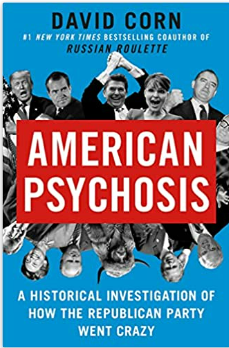You might think American Psychosis is just another book detailing the actions of the former (2017-2021) administration. It is not. That administration is discussed at the beginning of the book and then again in the last handful of chapters. What the book really provides is a must-read historical breakdown of the Republican party from the time of Lincoln to the present day.
The book basically chronicles how the Republican and Democratic parties shifted after the Civil War, during the reconstruction era through to the Jim Crow and Civil Rights era, and the internal strife of the party with the (at the time) more powerful moderates having to keep the right-wing nut jobs like Joseph McCarthy and Barry Goldwater in check. However, through the formation of the John Birch Society, the Heritage Foundation, and the Federalist Society, the nutjobs slowly gained more and more power in the party and eventually led to the takeover of the party by t***p, who was not afraid to spout the racist, xenophobic, and homophobic nonsense that the wingnuts were espousing for years. The author, David Corn, describes how Dwight Eisenhower had to essentially put up with McCarthy because he was afraid of losing his base (sound familiar), and Nixon fully embraced the "southern strategy" which basically is how the GOP keeps a hold of the bible-belt states, and how Ronald Regan (who was actually one of the worst Presidents in history if you were poor and/or a minority) was more than willing to play footsie with the racists in the party while keeping his inclusive persona. Corn's argument is that t***p did not change the GOP, but was a product of what was a long time coming because of the likes of those mentioned along with people like Pat Buchanan, Newt Gingrich, Sarah Palin, and their ilk.
The one thing I personally would have liked Corn to devote more time to was how, after the Civil War up through the 1960s, some prominent Dixiecrats (southern democrats, many of whom were ex-confederates who were somehow allowed into the government after the Civil War) switched from the Democratic party to the Republican party, and really started the wingnut portion of the GOP caucus. He talks around the subject but does not really go into a lot of detail about how that shaped what we have now.
Overall, the book is a very good history lesson that chronicles how the modern-day GOP arrived at the place it is. Corn backs up his assertions by citing multiple sources and/or providing examples (e.g., interviews, records of speeches, etc.) of the events he writes about. If you are at all interested in history or politics, this is a must-read.

No comments:
Post a Comment
Note: Only a member of this blog may post a comment.